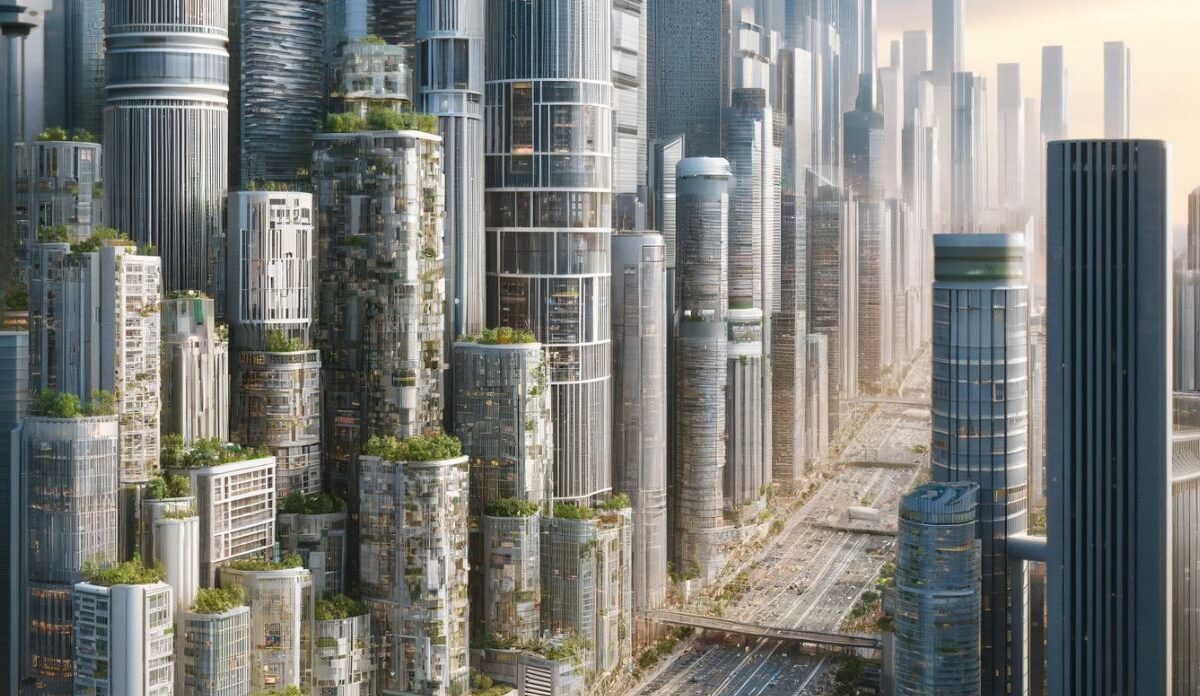The Art of Adaptive Reuse in a Space-Constrained City
Posted June 1, 2024

In the bustling metropolis of Los Angeles, where every inch of space is precious, architects face a unique challenge: how to transform old, underutilized buildings into modern marvels that reflect the city’s dynamic spirit. This is where the art of adaptive reuse shines, offering a creative solution to repurpose existing structures and breathe new life into the urban landscape.
Preserving LA's Heritage:
Los Angeles is rich in history, with many iconic buildings that hold cultural significance. Adaptive reuse allows architects to preserve this heritage by revitalizing historic structures while incorporating contemporary elements. From old warehouses in the Arts District to abandoned factories in Downtown LA, these buildings tell stories of the city’s past and offer a glimpse into its vibrant future.
Sustainability in the City:
In a city like Los Angeles, where space is limited and environmental concerns are paramount, adaptive reuse is not just a design choice but a sustainable necessity. By repurposing existing buildings, architects reduce the need for new construction, conserve resources, and minimize waste. This sustainable approach aligns with LA’s commitment to green initiatives and urban renewal.
Creative Solutions for Limited Space:
With land scarcity being a prevalent issue in Los Angeles, architects must think outside the box when it comes to utilizing available space. Adaptive reuse offers creative solutions to maximize square footage and functionality within existing structures. From converting old industrial buildings into mixed-use developments to transforming historic theaters into vibrant cultural centers, architects in LA are reimagining spaces in innovative ways.
Vertical Expansion
Utilize vertical space by adding additional floors or levels to existing buildings, especially in areas where height restrictions allow for upward growth. Vertical expansion is a strategic solution used in cities like Los Angeles to maximize land use. It involves adding floors to existing buildings, conserving land and preserving historical character. This approach is cost-effective, environmentally sustainable, and promotes architectural innovation. Overall, vertical expansion addresses space constraints while creating resilient urban environments.
Rooftop Gardens and Terraces
Transform unused rooftop areas into green spaces, rooftop gardens, or outdoor terraces that enhance livability and provide recreational areas for residents. Rooftop gardens and terraces offer innovative solutions for reusing space in cities like Los Angeles. They maximize usable space by utilizing rooftops, creating green areas for relaxation and socialization. These amenities also provide environmental benefits, such as reducing the heat island effect, improving air quality, and supporting urban biodiversity. Additionally, rooftop gardens serve as community spaces, fostering a sense of community and well-being among residents. They can also contribute to urban agriculture, promoting food security and sustainability. With their flexible design options and aesthetic appeal, rooftop gardens and terraces enhance the visual appeal of urban environments while promoting resilience and adaptability in the face of urban challenges.
Modular and Prefabricated Construction
Consider modular or prefabricated construction methods that can be assembled off-site and then installed quickly, minimizing disruption and maximizing efficiency in tight urban settings. Modular and prefabricated construction methods are efficient solutions for addressing space constraints in cities like Los Angeles. These methods involve assembling pre-made building components off-site and then transporting and assembling them on-site, reducing construction timelines and minimizing disruption. This rapid construction process ensures high-quality buildings with controlled manufacturing and promotes sustainability by reducing waste and improving energy efficiency. Additionally, modular and prefabricated buildings are adaptable to diverse architectural designs, cost-effective, and well-suited to urban contexts, making them valuable tools for creating innovative and resilient urban environments.
Shared Spaces and Co-Living
Design communal spaces and co-living arrangements that foster a sense of community and shared amenities, making efficient use of limited space while promoting social interaction. Shared spaces and co-living arrangements are efficient solutions for space-constrained cities like Los Angeles. By combining residential units with communal areas, they maximize space utilization and foster community engagement. These setups offer affordability, flexibility in living arrangements, and promote sustainability through resource sharing and eco-friendly practices. Additionally, shared spaces contribute to urban revitalization by repurposing existing buildings and creating inclusive, diverse communities that enrich neighborhood vibrancy.
Adaptive Floor Plans
Create flexible floor plans that can adapt to changing needs over time, such as convertible living spaces or movable partitions that allow for customization and versatility. Adaptive floor plans are a smart solution for cities like Los Angeles dealing with limited space. These plans maximize usage by incorporating versatile layouts that can easily adapt to changing needs. They often feature multi-functional spaces and modular design elements like movable walls or fold-down furniture, optimizing every square foot. Additionally, adaptive plans prioritize accessibility and sustainability, with features such as universal design principles and energy-efficient solutions. Residents can customize their living spaces while maximizing functionality and comfort, making adaptive floor plans a valuable solution for urban living in space-constrained cities.
Mixed-Use Developments
Integrate multiple functions within a single building or complex, such as combining residential units with retail, office spaces, or cultural venues, to optimize land use and create vibrant urban environments. Mixed-use developments are strategic solutions for space-constrained cities like Los Angeles. By combining residential, commercial, and recreational spaces within a single area, these developments optimize land use and create vibrant urban environments. They reduce commute times, support economic growth, and enhance urban design with pedestrian-friendly layouts and diverse architectural styles. Mixed-use developments improve quality of life by providing easy access to amenities and promoting social connectivity. They also adapt to changing needs over time, ensuring long-term sustainability and relevance in urban living.
Micro-Units and Compact Living
Design compact living spaces, known as micro-units, that are efficiently laid out to maximize functionality and storage while still providing comfortable living areas. Micro-units and compact living spaces are efficient solutions for space-constrained cities like Los Angeles. These smaller living areas optimize space utilization with smart storage solutions and multipurpose furniture. They are affordable options, making them accessible to various demographics and reducing environmental impact by consuming fewer resources. Additionally, compact living promotes urban density, locates residents in central areas with convenient access to amenities, and encourages a minimalist lifestyle. Overall, micro-units and compact living contribute to creating dynamic and sustainable urban environments while addressing the challenge of limited space.
Utilization of Underutilized Spaces
Explore opportunities to utilize underutilized spaces, such as vacant lots, or underutilized buildings, for innovative uses like pop-up shops, art installations, or community gardens. Utilizing underutilized spaces is a strategic solution for cities like Los Angeles facing space constraints. This approach involves repurposing existing infrastructure, such as old buildings or vacant lots, to optimize land use. Adaptive reuse plays a key role, transforming neglected structures into functional spaces for various purposes, from residential to commercial or cultural. Mixed-use developments often emerge from this strategy, combining different functions within a single area and creating vibrant neighborhoods. Utilizing underutilized spaces contributes to urban revitalization, stimulates economic activity, and promotes sustainable practices by reducing urban sprawl and encouraging community engagement. Overall, this approach fosters dynamic, resilient, and livable urban environments while making efficient use of limited space.
These creative solutions demonstrate how architects can navigate the challenges of limited space in Los Angeles while creating sustainable, livable, and dynamic urban environments that enrich the city’s cultural fabric
Success Stories in LA
Los Angeles boasts numerous successful adaptive reuse projects that have transformed old spaces into modern masterpieces. The transformation of the Old Bank District into a thriving residential and commercial hub, the revitalization of the Historic Core with trendy lofts and eateries, and the adaptive reuse of the Brewery Arts Complex as a creative community are just a few examples of how adaptive reuse has revitalized neighborhoods and contributed to the city’s cultural and economic growth.
Challenges and Opportunities
While adaptive reuse presents exciting opportunities for architects in LA, it also comes with challenges. Navigating zoning regulations, building codes, and structural constraints requires careful planning and collaboration. Preservation of historic integrity while incorporating modern amenities is a delicate balance that architects must strike. However, with creativity, expertise, and a deep understanding of LA’s urban landscape, architects can overcome these challenges and create transformative spaces that define the city’s identity.
Adaptive reuse is not just a design trend in Los Angeles; it’s a vital strategy for sustainable urban development and cultural preservation. Architects play a crucial role in reshaping the cityscape by breathing new life into old spaces. As Los Angeles continues to evolve and grow, the art of adaptive reuse will remain a cornerstone of innovative design, celebrating the city’s history while embracing its future.








